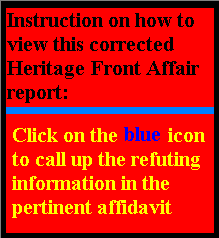 The
Heritage Front Affair
The
Heritage Front AffairA report to the Solicitor General of Canada
 The
Heritage Front Affair
The
Heritage Front Affair
The Source first came to the attention of CSIS through his contact with
diplomats from a foreign country in 1986. On January 29, 1986, CSIS learned
that a diplomat from a foreign country had been in contact with two people
"who were in a position to provide information of interest to that
country."
The Source's employer had been passing low level tidbits of information
to the country's Vice-Consul in Toronto for the past three years without
remuneration. The employer had developed a contact who was involved in
the opposition community in Toronto.
The Toronto Consulate official referred the Source and his employer to
an Intelligence Officer who was posted to the Embassy in Ottawa. The foreign
Intelligence Officer "assessed the Source's claims as being valid"
and he "wanted to develop the Source into an access agent into
the Toronto" movement.
A Security Officer for the foreign country's Embassy met with the Source
and his associate and said the Embassy needed a security firm to advise
on security devices. The Security Officer also asked the Source to register
him (the Officer) for university sessions on terrorism and videotape any
opposition demonstrations. The Toronto Region Investigator recognized that
the firm wanted the security contract despite the advice from CSIS that
they back out of the relationship.
CSIS approached the Source on March 6, 1986 following his meeting with
the foreign government diplomat and he agreed to cooperate with the Service.
The Source explained to the Toronto Region Investigator that he had a "contact"
with access to those Toronto groups which opposed the foreign government.
The foreign government representatives were developing the Source as an
agent when the Department of External Affairs, on August 20, 1986, expelled
one diplomat as "persona non grata" and did not permit
the second to return to Canada on the same basis. The next month, the First
Secretary at the Embassy renewed contact with the Source to continue to
develop him as an access agent. Despite this contact, it appeared that
the foreign Government lost interest in the Source. CSIS HQ suspected that
a friend of the Source may have been an asset of the embassy and informed
them that the Source was responsible for the "persona non grata"
actions.
In February 1987, the Source was re-directed to another target.
One factor which aided the decision to re-direct the Source was the fact
that he was acquainted with an individual who worked with a right wing
extremist. After the Source was introduced to the individual in February
1987, he contacted the CSIS handler "and provided unsolicited information
about Aryan Nations involvement (and) indicated that he would be willing
to infiltrate the right wing on behalf of CSIS."
When the Source met a CSIS Investigator from Toronto Region on February
26, 1987, the CSIS mandate on right wing targets was explained to him.
"He was also instructed that he could not break the law, regardless
of how petty an offense might seem (e.g. spray painting right wing slogans
or signs)."
The Source offered to recruit his friend, a former police officer. The
Investigator told the Source to keep the association with CSIS confidential.
On March 5, 1987, a police force contacted Toronto Region and said that
their informant received an offer by the Source to be introduced to a member
of CSIS.
After the first disclosure, the Source denied informing anyone of the CSIS
association and was informed "in no uncertain terms that his relationship
with CSIS must remain entirely confidential for his own protection."
The Investigator was uncertain if the police source was told about CSIS
by the Source or took an "educated guess".
At CSIS HQ, in April 1987, a Unit Head stated that "this file is
starting to smell a little funny" as he didn't like the way the
Source and his friend may have teamed-up. But as the Service's relationship
with the police was excellent and the source was under development, the
operation would continue under "tight control."
Toronto Region Managers concluded that the source operation was "not
seriously undermined" and they hoped that "rigid control
and direction will prevent any further breaches of security by this source."
CSIS Headquarters supported the continued development of the Source with
certain reservations, among them: "The source appears to be somewhat
overzealous, which may have compromised his confidentiality. Security precautions
should be reinforced and his progression in this field should be carefully
monitored and directed."
On June 11, 1987 the Toronto Region Investigator met with a police representative.
CSIS was told that a police source was again advised by the Source that
he was "currently working for the CSIS in a long-range operation."
CSIS HQ suggested and Toronto Region complied with the recommendation that
the Source be told that the Service's priorities had changed and that it
was no longer interested in his assistance. Contact with the Source ceased
at that point.
The Source next contacted the Toronto Region office over a year later
on November 4, 1988. He had met an individual with close contacts in the
extremist milieu. The Source felt that he should contact Toronto Region
to apprise them of the situation.
The Source told an Investigator that he had no personal interest in the
radical right. He was told by the Toronto Investigator to notify him of
any contacts with extremists.
In view of the Source's past indiscretions to the police source, the Investigator
offered no encouragement to the Source who, nevertheless said he would
"identify as many of the individual cell members as possible."
The Region worried about growing recruitment activities, particularly among
Skinheads. The Region's investigators thought that the violent right-wing
philosophy of the Identity Movement provided an excellent vent for the
frustration expressed by the 'Skinheads' and that they may, by fortunate
happenstance, have identified an acceleration of the violent activities
of the right-wing movement in Toronto in its embryonic stage.
The Region was not prepared to "let this developmental situation
go unmonitored" and the Source was "clearly the best equipped
to keep us abreast of developments."
On December 12, 1988 the Intelligence Branch of a second police force
contacted Toronto Region to advise that during the course of a criminal
investigation, a police source reported that the Source claimed to have
CSIS contacts.
The Regional Investigator commented that directional control had not been
a problem with this individual since he always ran any ideas past the investigator
prior to implementing them and was receptive when advised not to proceed
with a given plan. The Source was said to be an outgoing gregarious individual
who was easy to get along with, and a positive relationship existed between
him and the investigator.
In May 1989, the Source reported that a Nationalist Party leader attended
a party at Alan Overfield's house. Overfield was to become a prominent
figure two years later when he linked the Heritage Front to the Reform
Party.[1]
In the fall of 1988, the Source was invited to the residence of Don
Andrews, the leader of the Nationalist Party of Canada. Seeing him for
the first time, Andrews was precisely what the Source had expected: he
was obviously a radical; he acted as a cult-like figure.
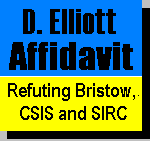 Seated
around Andrews' table with him at the weekly gathering were five people
who had jobs. The rest of those present stood around the table; numbering
about 10 people, Andrews called them his "Androids"[2]:
unemployed persons who lived in Andrews' rooming houses. We were told that
Andrews took the cheques they received, subtracted the rent and other expenses,
and gave them the rest
Seated
around Andrews' table with him at the weekly gathering were five people
who had jobs. The rest of those present stood around the table; numbering
about 10 people, Andrews called them his "Androids"[2]:
unemployed persons who lived in Andrews' rooming houses. We were told that
Andrews took the cheques they received, subtracted the rent and other expenses,
and gave them the rest 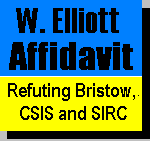 of
their money, making a big production at his meetings of having them come
up and get their money from him. Among other behaviours, Andrews berated
his people for not remembering certain acronyms, such as OMS (one man show),
during the tests that he administered.[3]
of
their money, making a big production at his meetings of having them come
up and get their money from him. Among other behaviours, Andrews berated
his people for not remembering certain acronyms, such as OMS (one man show),
during the tests that he administered.[3]
Among others in Andrews' coterie was David Maxwell French. He used to spend
his money on articles, especially uniforms, that belonged to dead Nazis.
Souvenirs of Nazis who were still alive were not acceptable. Consequently,
within the extremist movement, 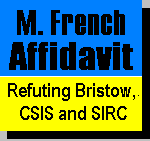 French
had the nickname, the "Necro-Nazi".[4]
French said he never heard the term "Necro-Nazi". Like
a "floating crap game", people gravitated from hate literature[5]
publisher Ernst Zundel to high school teacher Paul Fromm to Don Andrews
and back over time.[6]
French
had the nickname, the "Necro-Nazi".[4]
French said he never heard the term "Necro-Nazi". Like
a "floating crap game", people gravitated from hate literature[5]
publisher Ernst Zundel to high school teacher Paul Fromm to Don Andrews
and back over time.[6]
 A
significant event took place in April, 1989. Don Andrews conducted a special
meeting. His "Androids" were invited to his mansion. The
people present were introduced to a friend who had
A
significant event took place in April, 1989. Don Andrews conducted a special
meeting. His "Androids" were invited to his mansion. The
people present were introduced to a friend who had  been
been
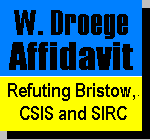 in
Toronto for just a few days: Wolfgang Walter Droege.
in
Toronto for just a few days: Wolfgang Walter Droege.
Droege had been released from Lompoc Prison in the United States on April
21, 1989 four years after his conviction on drugs, weapons and illegal
entry charges. He went to Toronto where he wanted to obtain money to establish
himself before he moved on to join his girlfriend in another province.
Droege was considered to be the senior statesman of the extreme right movement
and, as a privilege, he sat at the table in Andrews' house. Droege had
arrived in Canada with nothing, and so a considerable number of people
helped him by providing accommodation, food, and shelter. Droege fairly
quickly went to work as a part-time bailiff for Alan Overfield, a long
time friend and one-time associate of the Nationalist Party.
In July 1989 the Source reported that "Droege has mentioned an
interest in starting a group called 'Society for the Preservation of the
White Race' (SPWR)" and the Source opined that "any
group set up by Droege would almost certainly be action oriented."
CSIS told its Source to monitor the situation.
 The
next month, in August 1989, CSIS learned from the Source that Droege had
further developed his concept of a group separate from the NPC. The name
had changed to the "White Heritage Foundation" (WHF).
Droege described the proposed WHF as "a group of dedicated white
nationalists whose interest it would be to force the government to include
their (WHF) mandate in the government agenda. The WHF would also act as
a lobby group to protect the rights of white people." This would
be the public side of WHF.
The
next month, in August 1989, CSIS learned from the Source that Droege had
further developed his concept of a group separate from the NPC. The name
had changed to the "White Heritage Foundation" (WHF).
Droege described the proposed WHF as "a group of dedicated white
nationalists whose interest it would be to force the government to include
their (WHF) mandate in the government agenda. The WHF would also act as
a lobby group to protect the rights of white people." This would
be the public side of WHF. 
The WHF would also have a covert side to it. One of the covert activities
would be to set up an all white enclave. The WHF, under Droege's direction
would target a specific county or area and then use "whatever persuasive
methods or inducements necessary to convince non-whites to leave the area."
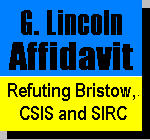 But
within the covert side would be still another level, an inner clique to
be known to a select few as the "Brethren". It would be
this group which would actually "control all aspects of the WHF."
This clique was to be unknown to regular WHF members. Two other defecting
members of the Nationalist Party of Canada, Gerald Lincoln and Grant Bristow
were being considered by Droege for positions in this group.
But
within the covert side would be still another level, an inner clique to
be known to a select few as the "Brethren". It would be
this group which would actually "control all aspects of the WHF."
This clique was to be unknown to regular WHF members. Two other defecting
members of the Nationalist Party of Canada, Gerald Lincoln and Grant Bristow
were being considered by Droege for positions in this group. 
Rumours were circulating in the NPC that another member and Grant Bristow
were "RCMP 'snitches'" and so Andrews suggested that Droege
should take Bristow around to meet people so that Droege could then vouch
for him.
The Source was among a group of seventeen people invited by Andrews
to travel to Tripoli to attend the 20th Anniversary Celebration of the
Libyan Revolution, from August 26, 1989 to September 4, 1989. Don Andrews
claimed that he could not go himself because he was involved in a Court
case and could not leave Ontario.
 The
Source believed that most people were chosen because they would not embarrass
Andrews and his Party. Those who owned luggage were also favoured. Another
criterion was money. There was to be a stopover in Rome for a plane change
and Andrews wanted people who had enough money to pay for their own accommodation
there.[7]
The
Source believed that most people were chosen because they would not embarrass
Andrews and his Party. Those who owned luggage were also favoured. Another
criterion was money. There was to be a stopover in Rome for a plane change
and Andrews wanted people who had enough money to pay for their own accommodation
there.[7]  Andrews
paid for most of the rest of the trip by using money advanced by Libya;
this was likely arranged through a Libyan agent.
Andrews
paid for most of the rest of the trip by using money advanced by Libya;
this was likely arranged through a Libyan agent.
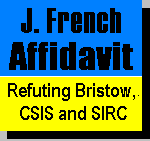 The
"anointed deputies" in the Andrews group were Nicola Polinuk,
June and Max French, Wayne Elliot, and Anne Ladas who was in charge of
the delegation, having been to Libya previously.[8]
The
"anointed deputies" in the Andrews group were Nicola Polinuk,
June and Max French, Wayne Elliot, and Anne Ladas who was in charge of
the delegation, having been to Libya previously.[8]
The travel itinerary called for a plane change in Rome on the way to Libya
and a one day stop there on the way back. The 17 representatives of the
Nationalist Party of Canada shared accommodation.[9]
In Rome, on the way to Libya, the group would await their flight for a
couple of hours. Asked to present passports in Rome, most of the NPC group
experienced no problems. Wolfgang Droege, however, was pushed to the side
along with James Dawson, Max French and June French. These four people
were on the same ticket and the Rome anti-terrorist squad wanted to interview
Droege  and
possibly dissuade him and the others from going to Libya. An Italian agent
was reported as saying: "its too hot in Libya" and Max French
said: "we'll put on shorts". Droege then told Max to "shut
your mouth."[10]
and
possibly dissuade him and the others from going to Libya. An Italian agent
was reported as saying: "its too hot in Libya" and Max French
said: "we'll put on shorts". Droege then told Max to "shut
your mouth."[10] 
The NPC group flew from Rome to Malta. There they were placed on a boat
later described by the group as a "converted prison ship"
which went from Malta to Libya. Gerry Lincoln, James Dawson, Wolfgang Droege,
and Grant Bristow roomed together in what was called a "bottom-dungeon".
The right wing racists had to be separated from the left wing anti-fascists
for the former's protection.[11] 
 After
the ship docked, the NPC group were not allowed to disembark and only after
several days of complaining were they allowed to reside in
After
the ship docked, the NPC group were not allowed to disembark and only after
several days of complaining were they allowed to reside in 
 Camp
Kadhafi some miles from Tripoli.
Camp
Kadhafi some miles from Tripoli.
At the Camp, the Nationalist Party group was told that there would be a
parade in a stadium; anyone who participated had to wear Muammar Kadhafi's
green uniforms. If her group complied, Anne Ladas would get to sit near
Kadhafi.  Max
French, always preoccupied with wearing uniforms, desperately wanted to
wear one in the parade.
Max
French, always preoccupied with wearing uniforms, desperately wanted to
wear one in the parade.
Droege, and the others were told of the plan to wear uniforms and march
in the parade. Droege stood up and said he would not do it. At first, it
was sixteen to one against him. However, the Source did not want to be
videotaped in a Libyan uniform and so he stood up and supported Droege.
Ladas then said she would tell the Libyans and they would give the Source
and Droege a hard time. These words stimulated a groundswell of support
from those who agreed with the two dissidents, including Lincoln and Dawson.[12]
Max French called the two dissidents every imaginable name and was most
disappointed with the decision, but he eventually received his uniform.[13]
French denies this account. 
Droege had defied the Party line and created a division between himself
and Andrews. Droege told the Source that he had realized that Kadhafi's
government supported the African National Congress which was killing whites
in South Africa. This made the regime anathema to him, from a racist ideology
point of view.[14]
On the return flight from Rome, some members of the delegation examined
their tickets and saw that the return route was: Rome-Chicago-Toronto.
When Anne Ladas was asked about this, she was reported to have said that
the Chicago stop only involved waiting in the international transit lounge.
Droege was not allowed to enter the United States as a condition of his
release from prison there. He had served four and a half years of a thirteen
year sentence and he was prohibited from re-entering the United States
for five years.[15]
On the airplane to Chicago, Droege sat beside Grant Bristow rather than
James Dawson who was a very large person. The stewardess handed out the
customs declarations and it was evident that Droege and his group would
formally enter the United States. Droege asked "what are we going
to do" and Bristow responded, "we'll probably get arrested".[16]
Droege protested to the Alitalia staff on the plane. He told Bristow to
instruct the others to clear Customs and Immigration and then call Andrews
when they landed. Droege wondered whether Andrews had conspired to have
him arrested, given the routing. Droege could have been reincarcerated
for another nine years in jail if things had gone badly for him.[17]

 Droege
wanted to stay on the plane and fly back to Rome, but the aircraft Captain
told him either to get off or be charged with piracy.[18]
Droege
wanted to stay on the plane and fly back to Rome, but the aircraft Captain
told him either to get off or be charged with piracy.[18]
 The
NPC members were arrested and some received threats from US officers. They
were strip-searched and had their body cavities probed for contraband.[19]
The
NPC members were arrested and some received threats from US officers. They
were strip-searched and had their body cavities probed for contraband.[19]
 The
entire group, including the Source, were detained by US Customs for several
hours and subjected to interviews. The Nationalist Party of Canada people,
except Droege, were then allowed to go through passport control and clear
Immigration.[20]
The
entire group, including the Source, were detained by US Customs for several
hours and subjected to interviews. The Nationalist Party of Canada people,
except Droege, were then allowed to go through passport control and clear
Immigration.[20]
Anne Ladas and Nicola Polinuk telephoned Don Andrews who instructed them
to come back to Canada. Andrews told Bristow to retain a lawyer for Droege
while the rest of the group returned to Toronto as soon as permitted.
Andrews then spoke again to Ladas and Polinuk. They left for a short time
and then returned with $1,000 which they gave to Bristow for Droege. The
funds were Libya's gift to the Nationalist Party of Canada. Lincoln, Dawson
and the rest of the group contributed $250 to pay for a hotel for Bristow.
A member of the group called the Canadian Consulate to inform them of Droege's
arrest.[21]
Following Andrews' instructions, Bristow contacted a lawyer for Droege
in Chicago. He then contacted a representative of the Canadian Consulate.
The diplomat informed Bristow there was no point in waiting around and
he could return to Canada. Bristow took the advice.[22]
Prior to Bristow's departure, he gave the lawyer $1,000 as a retainer,
and a list with the names of the Alitalia Airline employees who were present
when Droege made his protest. The German lawyer who began the case was
not available when Droege was to appear in Court. A Jewish lawyer from
the same legal firm represented him. Droege was quite "seized up"
when it happened, but would laugh about it later with his Heritage Front
associates.[23]
The lawyer told Droege that for an extra $2,000, he could get Droege out
immediately. Otherwise, he would languish in prison for some time before
release. Droege was freed after forty-eight hours.
 Droege
was released and driven to Niagara Falls by the American authorities at
night. At the border, he took a bus which arrived at 6:00 in the morning
in Toronto. Droege called Don Andrews to inform him of his arrival and
Andrews invited Droege to come over for breakfast.[24]
Droege
was released and driven to Niagara Falls by the American authorities at
night. At the border, he took a bus which arrived at 6:00 in the morning
in Toronto. Droege called Don Andrews to inform him of his arrival and
Andrews invited Droege to come over for breakfast.[24]
When he arrived, Droege found a policeman with Andrews. The officer told
Droege that Andrews had nothing to do with the arrest and placed the blame
on an Andrews "Schlep." This person, it was said, had
tried to make a deal that if he were given a passport, he would be the
eyes and ears of the OPP for what happened in Libya. The OPP did not accept
the offer.[25]
 Tensions
were high in the NPC after the trip to Libya, particularly among those
who had gone there.
Tensions
were high in the NPC after the trip to Libya, particularly among those
who had gone there.  The
entire group had worried about being attacked in Libya, they were arrested
in Chicago and they were subjected to humiliating interviews and body cavity
searches; people were generally tired and fed up.
The
entire group had worried about being attacked in Libya, they were arrested
in Chicago and they were subjected to humiliating interviews and body cavity
searches; people were generally tired and fed up. 
James Dawson was turned back in a subsequent attempt to enter the USA and
the Source reported that all who went to Libya felt that they too were
on the Watch list. Several in the group (Dawson, Lincoln, Wayne and Donna
Elliot) were thinking of breaking with the Nationalist Party and "throwing
their support behind Droege."
The general consensus was that Don Andrews' actions and, in particular,
the Libyan trip, did the most to cause people to leave the Nationalist
Party of Canada.
On September 25, 1989 the Heritage Front was formed by Wolfgang Droege
at a meeting attended by Gerald Lincoln, Grant Bristow and James Dawson.
These people were foils to Droege,  according
to the sources we contacted. Gerry Lincoln would be the president while
Droege and Bristow would work "behind the scenes as 'silent' executives."
according
to the sources we contacted. Gerry Lincoln would be the president while
Droege and Bristow would work "behind the scenes as 'silent' executives."
Wolfgang Droege, under oath, told the Review Committee that:
"I already had this idea for a number of years myself, but I
said to them basically, 'Fine, but I'm not going to be the one who is going
to do all the work. If I have the support of others, I am willing to form
an organization, and if I don't, I'm not going to do it myself.' So, especially
Gerry Lincoln and Grant Bristow assured me that they would be totally supportive
if I were to start an organization".[26]
The precipitating event was the trip to Libya, Droege stated that the
Nationalist Party people challenged him and
"So, that is what then really led me to say, 'When we get back,
we will start an organization'... and some time in October of 1989 that's
when I said, 'Okay, let's do it.'"[27]
Droege said that he suggested the name for the Heritage Front and "I
was the one who most people tended to follow because most people felt I
had put myself on the line a number of times."[28]
He also said that even if Bristow and Lincoln had not supported the idea
of the Front at that time, "I felt eventually it would happen because
I totally disagreed with Mr. Andrews' positions or his views."[29]
As the person with the most contacts in the extreme right, he said that
"I wanted to go to these people and say, 'Okay, the intention is
to form an organization which is to be national rather than just regional,
an organization which an average Canadian can identify with."[30]
James Dawson registered the Heritage Front on October 2, 1989. During that
week, Droege held a meeting with Lincoln, Jim Dawson and Bristow where he said the HF will
have a "Kosher-Conservative" line publicly but will use
the group to "clandestinely forward the white supremacist movement."
Lincoln said there was no clandestine agenda.
meeting with Lincoln, Jim Dawson and Bristow where he said the HF will
have a "Kosher-Conservative" line publicly but will use
the group to "clandestinely forward the white supremacist movement."
Lincoln said there was no clandestine agenda. 
In CSIS' Toronto Region, the Acting Regional Director General confirmed
the tasking of a source against Droege on October 4, 1989 for six months.
Droege became a Level 2 target on that date. The handling of the Source
was reassigned to a more senior Investigator on October 3, 1989.
 The
original concept for the Front, as defined by Droege, was that there would
be two "wings": a political wing and a military or direct
action wing. The political wing would be made up of people who were not
suitable for activist work; that is to say, they would engage in political
propaganda work. The people in the military wing would work at demonstrations
and they would distribute leaflets. We learned that Droege also formed
the October 2nd Committee, "an
The
original concept for the Front, as defined by Droege, was that there would
be two "wings": a political wing and a military or direct
action wing. The political wing would be made up of people who were not
suitable for activist work; that is to say, they would engage in political
propaganda work. The people in the military wing would work at demonstrations
and they would distribute leaflets. We learned that Droege also formed
the October 2nd Committee, "an  active
measures commando unit to be run by him and to use selected skinheads."
active
measures commando unit to be run by him and to use selected skinheads."
To distance the new Heritage Front from the NPC, Lincoln would publish
a newsletter, based on USA material with "no hate material, just
pro-white."
 The
Heritage Front was to have, in theory, four levels: the first would be
"the Brethren": Droege, Lincoln, and Bristow. The second
would comprise the Executive Council: James Dawson, the Brethren and rising
stars in the HF. The third would be the HF membership and the last level
would comprise supporters and subscribers to the new newsletter.
The
Heritage Front was to have, in theory, four levels: the first would be
"the Brethren": Droege, Lincoln, and Bristow. The second
would comprise the Executive Council: James Dawson, the Brethren and rising
stars in the HF. The third would be the HF membership and the last level
would comprise supporters and subscribers to the new newsletter. 
We learned that Droege intended to unite under the Heritage Front those
persons in Canada who  were
associated with The Order, the Ku Klux Klan and the Aryan Nations. The
Front would be the primary vehicle for "furthering the white supremacist
movement in Canada". Droege was going to contact white supremacists
in the United States to get their mailing lists of Canadian supporters.
were
associated with The Order, the Ku Klux Klan and the Aryan Nations. The
Front would be the primary vehicle for "furthering the white supremacist
movement in Canada". Droege was going to contact white supremacists
in the United States to get their mailing lists of Canadian supporters.
Droege's plan was not only to unite the white supremacists under the Heritage
Front banner. When that was accomplished, Droege wanted to buy land in
the Peterborough area, control the town council and try to legislate racist
views into the by-laws. 
 Droege
wanted the Heritage Front to be a more focused version of The Order in
the United States. The group would attack armoured cars and black drug
dealers for funds. The Front, according to the Source, would not target
minorities but rather, it would use selective violence against "race-traitors":
those Christian whites who disagreed with white supremacist views.[31]
Droege
wanted the Heritage Front to be a more focused version of The Order in
the United States. The group would attack armoured cars and black drug
dealers for funds. The Front, according to the Source, would not target
minorities but rather, it would use selective violence against "race-traitors":
those Christian whites who disagreed with white supremacist views.[31]
Droege hoped to get cash from the Libyans in return for information on
Jewish groups in Canada. To this end, Droege asked Bristow to accompany
him to Montreal to learn which Libyan officials he should contact in Canada.
Droege hoped to obtain major funding from the Libyans.
Droege decided to include the other people assisting him as equals: Dawson
registered the Heritage Front and all four would pay for its start up:
Droege paid one half and Lincoln and Bristow each paid a remaining quarter
of the start up costs. These comprised a $50 registration fee, letterhead
stationary and several other expenses for a total of approximately $300
to $350. There was no office and no staff to pay.[32]
The Up Front magazine would cost $1,000 an issue to print but it would
come out only in 1991. A description of financial issues is provided in
chapter VI.
 Droege
needed people to take action on his ideas and someone to put these ideas
on paper: he used Lincoln for that purpose. By October 2, 1989, Gerry Lincoln
was writing all the materials and all the propaganda. In addition to propaganda,
the Source reported that Lincoln later gave large amounts of his money
to pay for the publication of Up Front Magazine, the Heritage Front's major
propaganda outlet and, eventually, "cash cow".[33]
Lincoln said he did not provide a great deal of money for the magazine.
Droege
needed people to take action on his ideas and someone to put these ideas
on paper: he used Lincoln for that purpose. By October 2, 1989, Gerry Lincoln
was writing all the materials and all the propaganda. In addition to propaganda,
the Source reported that Lincoln later gave large amounts of his money
to pay for the publication of Up Front Magazine, the Heritage Front's major
propaganda outlet and, eventually, "cash cow".[33]
Lincoln said he did not provide a great deal of money for the magazine.

In regard to the 'active measures' cell called the 'October 2nd Committee',
the Source was initially tasked to be a member and assist in this cell's
training and operations. The Source was able to decline the offer, indicating
to Droege that it was not his style. The Source had been instructed by
the CSIS Investigator "to remove himself from any potentially criminal
endeavour being planned by the HF or its commando cell." 
 Droege
generated some ideas for making money to pay for the Heritage Front.[34]
Among them were "taking down" drug dealers to get the
money. The Source raised the problem of their having guns, and used other
arguments to try to dissuade Droege from pursuing this and like ideas.[35]
Droege
generated some ideas for making money to pay for the Heritage Front.[34]
Among them were "taking down" drug dealers to get the
money. The Source raised the problem of their having guns, and used other
arguments to try to dissuade Droege from pursuing this and like ideas.[35]

Droege made Grant Bristow his assistant because he could "take
the heat".[36] In 1989 and afterwards,
there were two security chiefs in the Heritage Front: Eric Fischer and
Grant Bristow. Bristow had floating responsibilities as Droege had various
visions of what he wanted to happen. Grant Bristow was also appointed as
an office manager (of sorts) to supervise the administrative requirements
of the HF.
Mainly, however, Bristow was there to help Droege find cars for his bailiff
duties. Droege was working for Al Overfield, repossessing cars. But before
they were repossessed, they had to be found. Bristow was good at locating
cars.
Droege said that Bristow was important to him because Grant "showed
him the ropes" after he (Droege) began working for Accurate Bailiff
Services run by Al Overfield. For this initial help, Droege owed Bristow
a lot, and a strong friendship developed. He continued, in part, to shield
Bristow from attacks by other members, who often alleged that he was an
informant, because of this initial friendship.[37]
Toronto Region reported to CSIS HQ on October 10, 1989 that Droege was
founding the Heritage Front based on the September 26, 1989 meeting.
CSIS continued to have considerable concern about the Source's association
with Droege: "in view of Droege's background, source should be
advised to avoid any involvement in illegal activities". Nevertheless,
the Source was instructed to report on him.
The Service stated that due to Droege's record of criminal activity and
his stated intention to conduct robberies in order to gain funding for
the HF, a brief on their interest in his activities would be provided to
the RCMP [38] HQ said that ...Toronto Region's
cooperation and judgement would be relied upon to ensure that the Source's
association with Droege did not become a matter of police responsibility.
The Service watched the development of the HF with great interest. The
Source and Droege attended the Northern Foundation Conference where the
former's presence "was beneficial in allowing the Service to monitor
Droege's launching of the HF."
As 1990 began, the Source was targeted against Wolfgang Droege by virtue
of his increasingly lead role in the white supremacist movement in Canada.
The Service acknowledged that Droege had included the Source in the top
level of his new organization and continued to trust the source and utilize
his talents in an effort to further his political aspirations; others were
added later.
The fundamental reason that CSIS kept the Source targeted against Wolfgang
Droege was to give the Service time to assess the greatest threat and adjust
accordingly. Their main concern was that if Droege becomes the leading
Aryan movement personality in Canada his organization would be harder to
penetrate due to his past experience and security consciousness. If this
scenario were to materialize they would be fortunate to have a source in
on the ground floor.
1 In the 1970's Alan Overfield had been an active member of the
right-wing Edmund Burke Society and the violence prone Western Guard Party.
During 1972, Overfield was one of the Western Guard members who received
firearms training at a camp north of Kaladar, Ontario. In the 1980's Overfield
became associated with the Nationalist Party of Canada. Mr. Overfield denies
being prone to violence.
2 SIRC interview of source.
3 SIRC interview of Source.
4 SIRC interview of Source.
5 Mr. Zundel indicated that he published "truth literature",
not "hate literature", and that he has never been convicted of
publishing hate literature.
6 SIRC interview of Source.
7 SIRC interview with source.
8 SIRC interview with Source.
9 SIRC interview with Source.
10 SIRC interview with Source.
11 SIRC interview with Grant Bristow.
12 SIRC interview with Source.
13 SIRC interview with Source.
14 SIRC interview with Source.
15 SIRC Hearing, Wolfgang Droege.
16 SIRC interview with Grant Bristow.
17 SIRC interview with Grant Bristow.
18 SIRC interview with Grant Bristow.
19 SIRC interview with Source.
20 SIRC interview with Source.
21 SIRC interview with Grant Bristow.
22 SIRC interview with Grant Bristow.
23 SIRC interview with Grant Bristow.
24 SIRC interview with Source.
25 SIRC interview with Source.
26 SIRC Hearing, Wolfgang Droege.
27 SIRC Hearing, Wolfgang Droege.
28 SIRC Hearing, Wolfgang Droege.
29 SIRC Hearing, Wolfgang Droege.
30 SIRC Hearing, Wolfgang Droege.
31 Mr. Droege does not agree with the expression "more focused".
He says that he learned from the mistakes of the Order and stated that
that was not a way of successfully promoting the ideas of the Heritage
Front. He denies all that is said in the paragraph.
32 SIRC interview of Grant Bristow.
33 SIRC interview of Source.
34 SIRC interview of Source.
35 Mr. Droege denies promoting robberies to fund the Heritage Front.
36 SIRC interview of Grant Bristow.
37 SIRC interview with Wolfgang Droege.
38 Mr. Droege denies promoting robberies to fund the Heritage Front.